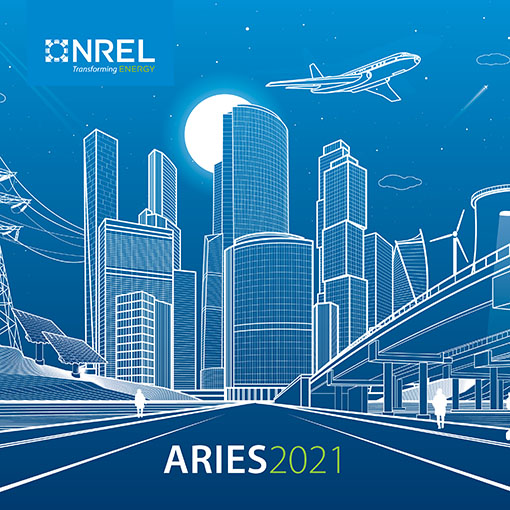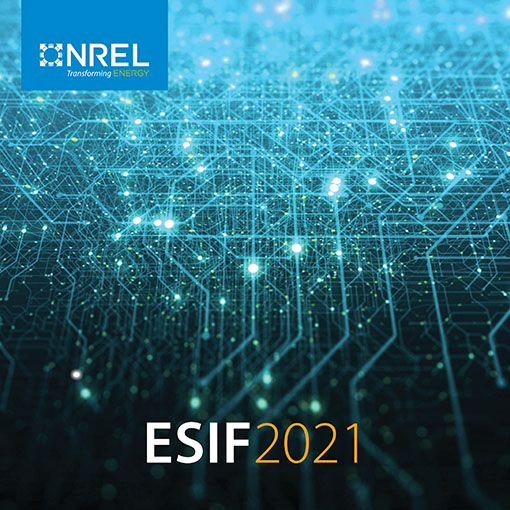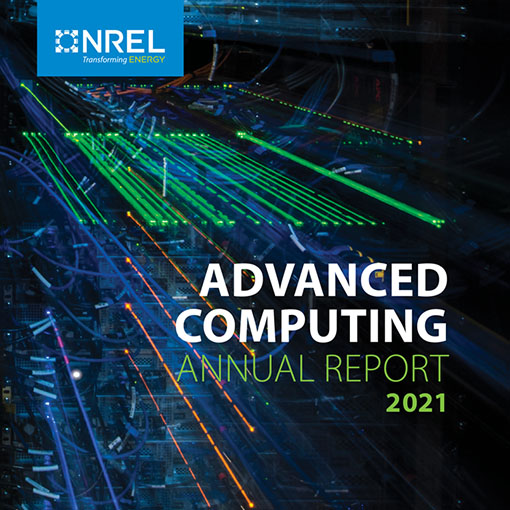The Year in Review
Impact Reports Showcase Research in Powering the Clean Energy Transition
The recently released 2021 annual reports for the the Advanced Research on Integrated Energy Systems (ARIES) research platform, Energy Systems Integration Facility (ESIF), and Advanced Computing offer a snapshot of the impact of National Renewable Energy Laboratory (NREL) research: highlights from the diverse projects, publications, patents, partnerships, and technical breakthroughs realized in the last year.
ARIES 2021 Report
The ARIES research platform is the United States' most powerful research capability to support the transition to a clean energy future. It is already helping meet the challenge of integrating technologies that have not previously worked together and managing the variability in the physical size of new technologies being added to energy systems.
In its first year of operation ARIES performed a black start using 100% renewable resources after an unexpected outage, proved how multiple resources can work together as a hybrid power plant, and designed renewable energy microgrid systems with the U.S. Department of Defense. To develop better transportation practices, ARIES has been at the center of an extensive collaboration to modernize ports.
The ARIES virtual emulation environment joins the resources in the ESIF to the 20 MW of power hardware at NREL's nearby Flatirons Campus. Within the digital-physical ecosystem, researchers can practice securely controlling large numbers (millions to tens of millions) of interconnected devices in digital-physical replicas of real-world systems.
Through high-speed internet connections, ARIES demonstrated the exchange of test data between research equipment at Pacific Northwest National Laboratory and NREL. These are the first steps to developing a federated lab complex or global SuperLab that can conduct research that no single lab or entity could achieve on its own.
ESIF 2021 Report
For nearly a decade, the ESIF has consistently been at the forefront of clean energy systems integration and grid modernization, with support from the U.S. Department of Energy Office of Energy Efficiency and Renewable Energy. Entire cities, the U.S. government, and the world's largest energy companies are now turning directly to our laboratory for the technical knowledge and physical capabilities that can facilitate an energy transformation like none other in history.
In 2021, projects with industry partners resulted in new demand-flexible technologies to decarbonize energy consumption in supermarkets and a design tool for effectively incorporating end-of-use batteries in hybrid energy storage systems. Meanwhile, Holy Cross Energy tested an AI-based tool for resilient microgrids that will be deployed in a remote 5-MW community in Colorado.
Leveraging a rich history, the ESIF is now the tip of the spear for ARIES, a platform that performs research at a scale that reflects the real diversity and size of energy system transitions. NREL can perform electric grid experiments at 10 times greater power than before.
Within ARIES, the ESIF maintains its original role of leading research at the grid edge to better integrate clean energy technologies while advancing grid reliability, security, and resilience. We are also achieving extraordinarily detailed analysis of interdependent systems and leveraging artificial intelligence (AI) using high-performance computing. When this supercomputer processing is used alongside our hardware and research assets, NREL achieves an impact in energy systems integration research that is available nowhere else.
Advanced Computing 2021 Report
Advanced computing supported more than 300 projects in fiscal year 2021—the most conducted in a single year to date. NREL's high-performance computing (HPC) experts developed cross-cutting capabilities that made rapid-breakthrough science possible in advanced manufacturing, bioenergy, energy storage, grid modernization, and much more.
The Eagle supercomputer ran more than 100 million simulations in service of the monumental Los Angeles 100% Renewable Energy Study (LA100), a rigorous analysis to chart how the second-largest city in the nation could achieve a 100% clean energy future by 2045. HPC resources are also being leveraged to scale up geospatial resolution in support of NREL's 2021 R&D 100 award-winning tool dGen™, an open-source software that predicts rooftop solar installations through 2050.
To stay at the cutting edge of the latest advancements in HPC technology, NREL finalized the contract to acquire its next-generation HPC system, named Kestrel. When completed—in early 2023—Kestrel will accelerate energy efficiency and renewable energy research at a pace and scale more than five times greater than the current system.
NREL houses one of the most energy-efficient data centers in the world thanks to innovative warm water cooling and waste heat recovery. When the ESIF was conceived, NREL set an aggressive requirement that its data center achieve an annualized average power usage effectiveness of 1.06 or better. The facility ended last year with an average power usage effectiveness rating of 1.028.
By putting exceptional capabilities in the hands of our outstanding researchers and partners, NREL is unlocking the next steps toward clean, efficient energy everywhere.
Read the full reports:
Advanced Computing 2021 Report
This article has been updated to reflect an editorial change made after its original publication.
Last Updated May 28, 2025



